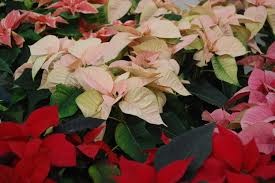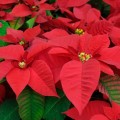- Mother’s Day Recipes You Can Make with Flowers - May 9, 2019
- Celebrating Flowers and Culture at the Shinnyo-en Lantern Floating Ceremony - March 29, 2018
- Give Easter Lilies This Spring - March 22, 2018
After the last few refrains of Christmas carols fade and the once magnificent tree’s dry needles have begun to carpet the floor, thoughts of packing up the decorations and starting off the new year fresh leaves one standing in front of pots of poinsettias and wondering what to do. While they make the perfect potted plants for the holiday season, the typical shelf life of a poinsettia falls far short of fruitcake, making it last about as long as the New Year’s resolutions in most US homes. What many people may not realize is that this holiday plant can make an excellent houseplant all year long with not much extra maintenance. Getting them to re-bloom in the coming year is an exciting challenge for anyone up to the task and even creating new ones from the existing plant is easy using the following guide for 2015.
January
If the poinsettia is wrapped in foil, remove it and place the container (be sure it has holes on the bottom) on a saucer in order to ensure proper drainage. Fertilize the plant with a multipurpose fertilizer and allow it the soil to dry completely between watering. While the poinsettia may look like a lush, tropical rainforest plant, it is actually native to drier parts of Central America and does best in soil that drains quickly and doesn’t sit in water.
March
By now, your poinsettia will have lost most of it’s winter color and instead resembles a long-legged and leafy green plant. Now is a great time to make more poinsettias by clipping off the top 3 to 4 inches of each branch. Dip these cuttings in a powdered rooting hormone available at your local garden center and place into moist potting soil in a warm, sunny room. Water the new cuttings more often, keeping soil moist for the first couple of weeks. If you are not interesting in making more poinsettias, it is still a great idea to trim back the top half of the plant to encourage new, more vigorous growth to form.
June
Once the threat of cold weather has past, your poinsettias would love a spot outside on a shaded porch or other location with indirect sunlight. Their foliage will add height to a planted container or they can be placed individually for a bit of greenery around the patio. Water as you would your typical bedding plants and cut back branches that get too tall or leggy.
September
Before the temperatures drop, cut back the the branches of your poinsettia until only a few sets of leaves remain above the soil level and bring inside. Water with a fertilizer and place in a sunny window. The red “flowers” of the poinsettia are actually brightly colored leaves that initiate when the plant gets a specific amount of light. If you’d like to have the poinsettia color up in time for the winter holiday season, expose it to about 11 hours of sunny light and 13 hours of darkness each day. This works great in a room that is not typically used every day, as one that has artificial light that is on at night can affect this cycle.
December
If you had a hard time following these directions, simply chuck the poinsettia and buy a new one each year. Better luck in 2016!





